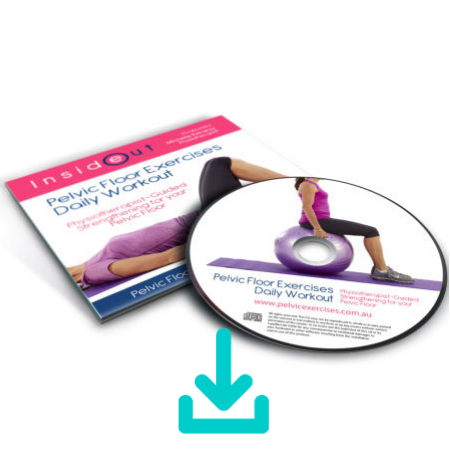
Pelvic exercises for pregnancy promote better strength, support and control and help you to relax your pelvic floor for childbirth.
These pelvic exercise guidelines teach you how to safely and effectively exercise your pelvic floor for pregnancy and childbirth. They are by Michelle Kenway, Pelvic Floor Physiotherapist and author of Inside Out – the essential women’s guide to pelvic support.
Read on now for complete guidelines for pelvic exercises for pregnancy including:
- Effect of pregnancy on the pelvic floor;
- The benefits of pelvic exercises for pregnancy and childbirth;
- Pelvic exercises for pregnancy daily exercise guidelines; and
- Expert tips for getting the most out of your pelvic exercises during pregnancy and beyond.

Pelvic Floor Exercises Workout
AUDIO CD OR DOWNLOAD NOW
Strengthen your pelvic floor with this daily Kegel exercises routine.
This evidence-based pelvic floor exercise workout guides you step by step.
Presented by:
Pelvic Floor Physiotherapist Michelle Kenway
Contents
Track 1 – Introduction to Successful Strengthening
Track 2 – Finding your Pelvic Floor
Track 3 – Feeling your Pelvic Floor Muscles
Track 4 – Using the Correct Pelvic Floor Exercise Technique
Track 5 – Beginners Pelvic Floor Exercises Workout
Track 6 – Intermediate Pelvic Floor Exercises Workout
Track 7 – Progressing and Maintaining your Strength
Effect of Pregnancy on the Pelvic Floor
A number of factors contribute to weakening of the pelvic floor during pregnancy:
- Hormonal changes cause the pelvic floor (muscles and tissues) to soften and stretch;
- Weight gain;
- Straining with constipation; and
- Inappropriate pregnancy and postnatal exercises such as intense core abdominal exercises and high impact exercise (e.g. jogging).
Benefits of Pelvic Exercises for Pregnancy and Beyond
Pelvic floor exercises for pregnancy help you in a number of ways including to:
- Counteract progressive stretching and weakening of the pelvic floor;
- Improve bladder control during and after pregnancy;
- Minimise the risk of long-term pelvic floor dysfunction (incontinence and prolapse); and
- Improve the ability to relax the pelvic floor muscles during 2nd stage of labour with better pelvic floor muscles awareness.
Pelvic Exercises for Pregnancy Guidelines
Choose a comfortable starting position:
The position where you best feel your pelvic floor muscles working:
- Lying on your side;
- Kneeling on your hands and knees;
- Kneeling leaning forwards over a fit ball;
- Sitting on a chair or a fit ball; or
- Standing tall.
(A) Long endurance pelvic exercises step by step
Long endurance pelvic floor exercises train the pelvic floor muscles to work for extended periods of time as you move around to support the weight of your growing baby
- Visualise your pelvic floor like a hammock or trampoline running between your pubic bone and your tail bone, and between your sit bones
- To activate your pelvic floor muscles lift and squeeze in and around your 3 pelvic openings (vagina, urethra and anus) – you should feel and inwards lift and squeeze with the correct action
- Keep lifting and squeezing your pelvic floor muscles for up to 10 seconds
- Release your pelvic floor muscles and relax your pelvic floor back to its normal resting position
- Allow yourself sufficient time to recovery before your next attempt
- Repeat these long pelvic floor exercises 20- 30 times every day
(B) Short quick pelvic exercises (i.e.“The Knack”) step by step
Short quick pelvic exercises help to support and protect your pelvic floor. “The Knack” is a quick strong pelvic floor contraction before and during cough or sneeze to help you to avoid unwanted bladder leakage.
- Visualise the position of your pelvic floor muscles (as outlined in A for long endurance exercises)
- Contract your pelvic floor muscles briskly and strongly for two seconds
- Release your pelvic floor muscles and relax back to resting position
- Repeat up to 10 short strong exercises in a row
Tips for Effective Pelvic Floor Exercises for Pregnancy 
- Commence your pelvic exercises early in your pregnancy
- Maintain good posture during your exercises- sit or stand tall
- Perform your pelvic exercises every day
- Make every exercise as strong as possible using the correct technique
- Try to breathe normally and avoid holding your breath during your exercises
- Use “The Knack” or a strong brisk contraction every time you cough or sneeze
- As pregnancy progresses you may find your exercises easier laying down
- Relax and rest your pelvic floor muscles – your pelvic floor should not be held constantly braced throughout your day.
If you apply these pelvic exercises for pregnancy guidelines you will be well on your way to better pelvic support and control during your pregnancy. And the best part? Pelvic exercises for pregnancy will be very likely set you on the path to better long-term pelvic floor strength and control well after your baby has been born.







